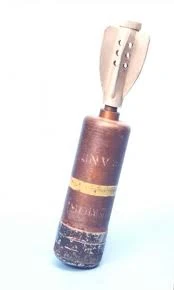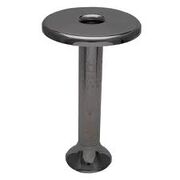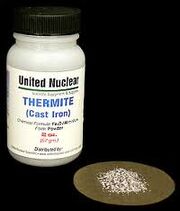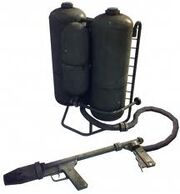| This page may have several issues that require cleanup.
You can help Zombiepedia by making improvements where possible. Please consult the Manual of Style. Check the discussion page for more information on these issues. |
| This page has subject matter that is highly disputed.
Discussion may be ongoing. Please view the Discussion page before making major edits. One the dispute is resolved, or tapers off, edits should be made freely. |
The effectiveness of fire as a weapon against zombies varies. Although fire is still one of mankind’s greatest tools, it's usage as a weapon in human history was dependent on pain, or fear of it - a trait zombies do not possess. As far as its destructive power, while it is true that fire can consume structures and even cities whole, one need only spend an evening trying to construct and sustain a campfire or firepit to see that even flammable materials can be fickle and difficult to destroy. Live (albeit undead) animated tissue is even more difficult to destroy, which is one reason fire is considered a last resort weapon against most documented types of zombies.
Overview[]
Much like Frankenstein's Monster, Romero Zombies are afraid of fire, so it can be used to escape a horde in some situation. Return of the Living Dead Zombies may or may not fear fire depending on the individual, but since the cause of reanimation is a chemical, attempting to burn a rotten Zombie in anything short of a modern crematory oven may cause the chemical to rise into the atmosphere and rain down somewhere else, starting a whole new undead plague. That is, assuming the "chemical" can survive the intense temperature of the fire, which is uncertain.

Incendiary Bomb.
However, most zombies do not even seem to notice fire at all, and trying to use fire to scare one off will likely get you bitten and burnt.
Fire can be used to weaken or slow zombies, however in most cases it is both easier and more time and resource efficient to use melee weapons, obsticles, or shelter.
One noteworthy exception is in World War Z, the Americans introduced "Cherry Pie" or PIE rounds at the Battle of Hope, basically a new sort of chemical incendiary round that maximized damage by frying a larger area of the penetrated tissue, allowing wounds that only lodge near the brain or spinal column to virtually char-broil those organ areas, putting the zombie down.
While not the tool for every job, fire is invaluable in disposing dead zombies and sanitizing any viruses they may carry. There are several things you’ll want to know before you decide to go torch the undead. First, any zombie set on fire isn’t going to instantly turn into ash. Assuming that the immolation can maintain its prescence on the head and neck area of the zombie for an extended time, it may take as much as half an hour for the fire to kill the brain, during which time you’ll have to deal with a shambling torch that sets fire to everything it touches. Second, fire has no ally. Using fire irresponsibly and recklessly is liable to start a house fire or wildfire, which may turn into a greater threat to your survival than the undead. Third, fire consumes oxygen to burn, which means using it in a confined space with poor ventilation may cause you to quickly asphyxiate.
However , fire can be a very good way to differentiate humans and zombies especially at night. Anything that keeps shambling towards you regardless of it is on fire is definitely a zombie.

A Modernized Torch.
Torch[]
The torch is for all intents and purposes a stick with one end tipped with flammable material, often soaked in flammable oils or liquids. The Torch is a multi-use device. It can be used to set objects on fire, light dark areas or signal others in the dark. It's use as a weapon is limited, as it requires one to be in close range of it's target to set them alight—which might not happen to begin with—and makes for an inferior distance weapon when thrown.
Blowtorch[]
A hand-held propane torch. They lack the heat necessary to puncture a human skull, and the flame is only a few inches long. Better used to set fire to something else.
Molotov Cocktails[]
A type of homemade incendiary weapon, usually consisting of petrol or

alcohol contained in a glass bottle with a cloth wick protruding out of the top. They are safer to manufacture than pipe bombs, though they are dangerous to handle when lit, and somewhat awkward to wield. Although easy to create, Molotov cocktails may or may not be effective against zombies. However, molotovs may burn themselves out before even slowing down a zombie, and in the meantime, the fire can easily spread to other fuel sources. Be very careful about where you throw these fireballs-in-a-bottle, as you are likely to set fire to whatever structure you are taking refuge in. However, Molotov cocktails can be useful in the safe disposal of infected corpses or infected zombies.
You can make a Molotov by getting a glass bottle. For the fuel you can use ethanol, menthol, gasoline, petrol, or alcohol. You fill the bottle with the fluid but only about ¾ full. You then seal the bottle and attach a rag around the neck (by tying, taping, with a rubber band, etc.) or tape a storm match to the side like in the picture above. Always remember to soak the rag in a flammable liquid before lighting it or else it will be difficult to ignite. For the storm match you can bring the strike pad but it will feel odd lighting it that way, or you can use a lighter.
Dousing with Fuel[]
This is very tricky to do, since you first need to find a way to soak the zombie or zombies in question with enough fuel to get the job done without getting grabbed, a way to ignite the fuel, and a way to get far enough away to avoid getting burned alive. Only recommended in defensive moats and the Pied Piper Strategy.
Exploding propane tank[]
Thanks to movies and films portraying this wrongly , people now think all it takes is a few well aimed shot on the propane tank to make it explode. This however is dangerously hard to perform as the wall of the propane container is very thick and strong to prevent puncture and leaking. It may take more than even intermediate rifle rounds to punch a hole on a propane gas tank. Secondly, for ease of transport and containment most propane is stored in liquid form and gases out easily on any leak, so it wouldn't stay in one place for too long and at most will only create a long propane flame that burns until the gas runs out. So there will not be a huge massive explosion and flames everywhere. However, liquid fuel tanks (such as petrol) have a more higher chance in exploding if one punctures the tank and set the leaking fuel on fire, exploding when the correct air fuel ratio mixture is achieved. Even so the main form of damage will be the shrapnel of the tank and not the fire itself.
Napalm[]
Napalm is flammable adhesive liquid that can sustain a high burning temperature. While technically, the name originated from the original popular formula of naphthenic and palm acids in gasoline, there are hundreds of different acceptable formulas that are known as napalm. It burns very hot and many kinds are durable enough to burn on the surface of a body of water.
Unlike most incendiary weapons, Napalm can be very useful against zombies. Napalm sticks to whatever it touches and burns for a long time and can easily render a zombie immobile if not just kill it outright. Note that this can take sometime, depending on the formula of the napalm and how much of the napalm got on the zombie in the first place.
If you touch inflamed Napalm, expect second and third degree burns. Concentrate on using other items to wipe the sticky fire off, more than dousing, or smothering the napalm.
Dragon's Breath Shotgun rounds[]
Dragon's breath rounds fire incendiary materials which light soft targets on fire, and at a fair distance, much like a flamethrower. The heat levels don't approach that of most flamethrowers, but shotguns don't suffer the same safety and weight issues as a flamethrower. However like all flame based weapons, they will take many minutes, if not hours to immobilize or kill a zombie. These rounds are hard to come by, as they are not widely used by military forces and illegal in most places.
Thermite[]
Thermite is a pyrotechnic compound that when ignited produces a high amount of heat than

A Thermite Jar.
can burn through most metals and could reduce the undead to ashes in a short period of time(or rather seconds). Thermite isn't an explosive but can be if used or made improperly. it can be used for hundreds of different reasons such as igniting a padlock or welded blockage to a certain area, or just using it to weld metal, and even possibly using it as a trap for the undead. Thermite consists of aluminum and iron oxide(rust) and a catalyst to ignite it, in this case, magnesium. However, it can be quite difficult and unreliable to ignite and isn't a mobile weapon and doesn't spread like other incendiary weapons do. It is very impractical to use in most combat situations.
Obtaining the Aluminum
- Find yourself an Etch-A-Sketch, the stuff inside is purely aluminum
- Go to a paint store they usually have powdered aluminum for paint mix
- Buy it online or at a hardware store
- Grind down things made of aluminum(i.e. soda cans, bicycle frames)
- Look in a police forensics kit. I'm not kidding, there's actually a whole jar of powdered aluminum in each and every one of them.
Obtaining the Iron Oxide
- Again you may go to a paint store and ask if they have any
- You can also buy it online as well
- You can purchase Steel Wool, cover it in a jar with water. Use a magnet to prevent the wool from floating, and next put 5 tablespoons of regular bleach and 5 tablespoons of regular vinegar and let it sit for a day or two. Then filter the brown paste into say a coffee filter and let it dry out.
- Scratch some rust off of something, then grind the rust into a fine powder.
Obtaining the Magnesium for ignition
- Fairy light firecrackers usually have magnesium in it to burn brighter
- Certain flare rounds and illumination grenades
- Certain engine blocks (like Volkswagen engines)
- Magnesium fire starters
Mixing
Thermite is approximately 8 grams of iron oxide to 3 grams of aluminum. The formula is by weight but aluminum is light so it will appear as a 50-50 mix. Put them in a container and mix them evenly. If you want, mix four parts thermite with one part clay for moldable thermite.
Igniting
Thermite requires high substantial amounts of heat so magnesium will do the trick, find magnesium ribbon or a sparkler that contains magnesium. Place the magnesium in a thermite pile and light it with a Torch.
Flamethrower[]

M2 flamethrower
Finding the weapon itself is difficult, let alone one that functions properly. Finding correct fuel will be harder than finding the weapon. Flamethrowers do require proper training to use, and homemade ones can be dangerous and unreliable. The recoil to the weapon is tremendous too and can be a shock to an untrained user. Ammo is extremely limited, lasting less than a minute of consecutive fire before it will require refueling. Flamethrowers are also notoriously heavy, with many models weighing in upwards of 70 pounds.
Problem number four is the worst drawback. The danger proximity is infinite. Despite precautions, you are always going to be in some type of danger even when zombies aren't present. It's dangerous when transporting, filling, carrying, and firing it. When in combat is the most it's dangerous. Fire needs oxygen to burn, so if you are in a dry place with little to no oxygen you are done for. Not only is fire unpredictable, the danger for self combustion is great along with suffocation, and smoke inhalation, further adding ways to die by flamethrower.
And number five, you gotta always watch the environment you're lighting up. Is there any combustible stuffs around? Is it large enough so the heat won't burst back to you? Is it open enough to prevent carbon monoxide buildup? Or to prevent the burning gas from splashing back to you? (Remember, gasoline flamethrowers used ignited gasoline, they still have their liquidity.) Doesn't matter if you're surrounded by zombies but still in possession of a flamethrower, if you're inside a barn made of wood you're dead either way.
However flamethrowers are quite useful in battlefield sanitations (disposing zombie bodies) by burning. It eliminates the need to burn zombies individualy by pouring gasolines on each one, which risks unexpected attacks from zombies that are downed but not dead.
M2 Flamethrower Specifications:
- Weight: 43 lb (19.5 kg) Empty & 68 lb (30.8 kg) Filled
- Rate of Fire: ~Half a Gallon per Second
- Effective Range: 651⁄2 Feet (20.0 Meters)
- Feed System: 2 (2 Gallon) Gasoline Tanks (Fuel) & 1 Nitrogen Tank (Propellant)
P.S. Believe it or not, flamethrowers are 100% legal to buy in the United States. There's just restrictions on where and when to use them. It could easily set the wielder's house on fire, but if there's a huge nest of angry hornets in your backyard, there's nothing like it, provided there's a government guy standing nearby who's legally required to be present when a flamethrower is used for that sort of thing.
Flare Guns[]

Flare guns are often used by the military if they can´t use radios to send a signal to HQ or nearby military camps in case of an emergency. As of this moment, modern flare guns and rounds are quite cheap and (with a little imagination and ingenuity) can reasonable up an arsenal economical.
